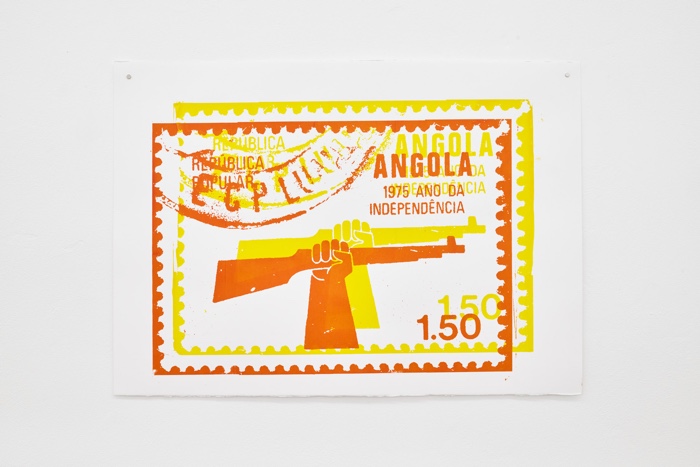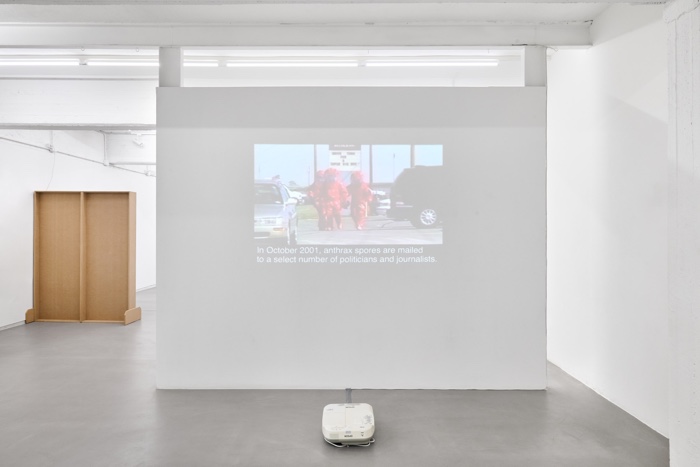The Stockholm International Peace Research Institute estimates that, between 2014-18 and 2019-23, European states nearly doubled their arms imports. Which suggests —-to no one’s surprise– that belligerent tensions are on the rise and, with them, the profits of the weapon industry.

Zazzaro Otto, KRIEG IN PRENZLAUERBERG, 2013

Stefano Serretta, Sutra 69 – 79 (Barricate durante la Rivolta di San Basilio, Roma, 1974), 2022. Installation view at ArtNoble Gallery. Photo: Michela Pedranti
Theatre of Dis-Operations. (Act I. A Disarmament), an exhibition at ArtNoble Gallery in Milan, presents techniques and tactics of disarmament processes as the primary urgency of contemporary society. Theater of operations, or theater of war, is the military term for the geographical area where an armed conflict takes place. It was also the title of MoMA’s 2019 exhibition Theater of Operations – The Gulf Wars 1991-2011. The exhibition at ArtNoble Gallery, however, goes beyond these two reference points by turning the theater of operations into a theatre of dissent, demilitarisation and desertion.

Délio Jasse, Francobollo 1975, 2024. Installation view at ArtNoble Gallery. Photo: Michela Pedranti

Zazzaro Otto, Per fare un tavolo ci vuole la guerra / To Make a Table You Need War, 2024. Installation view at ArtNoble Gallery. Photo: Michela Pedranti
Theatre of Dis-Operations is more than an exhibition, it is an invitation to push back against the normalisation and mercantilism of violence. The anti-military tactics and subversive procedures presented in the show range from sabotage to deconstruction of military symbols, from desertion to grassroots resistance against economic macrosystems that feed military culture. They are non-violent actions and tools to shake off hopelessness, attention fatigue and loss of humanity.
The show finds additional relevance in Italy, where far-right minister Matteo Salvini –never short of ideas he won’t pay the consequences of.- has proposed to bring back compulsory military service. I love every single artwork in the show. Here’s a few words about some of them:

Paolo Ciregia, Pugni, 2019
At the beginning of the war in the Donbas region of Ukraine, Paolo Ciregia photographed a group of soldiers. He focused on their hands. The image is striking: it is life-size and welcomes the visitor to the gallery with its tension and restrained aggressiveness. Hence the title: Pugni (“fists” in English). The hands are empty but they appear ready to take arms. The composition of the image –soldiers without faces, simple attires, unspecified location– suggests that these bodies are interchangeable, they are mere peons to be sacrificed in imperialist conflicts.

Paolo Ciregia, (CTS) “capture the shield”, 2024
I also loved Ciregia’s (CTS) “capture the shield”. The ready-made is a shield that Ukrainian soldiers stole from the Russian police and covered with Ukrainian revolutionary stickers.

Zazzaro Otto, KRIEG IN PRENZLAUERBERG, 2013
Zazzaro Otto built a Long John cargo bike using old bike parts and DDR army material. The work, titled KRIEG IN PRENZLAUERBERG (war in Prenzlauerberg), derides the omnipresence of this type of green transport vehicle in the Berlin district. Associated with the rapid gentrification of the area, the aesthetic of the bicycle also alludes to Germany’s weapon industry. KRIEG IN PRENZLAUERBERG is thus an ambiguous object that points both to Germany’s most deadly, polluting exports and to the capitalistic dimension of the country’s ecological ambitions.

Zazzaro Otto, Per fare un tavolo ci vuole la guerra / To Make a Table You Need War, 2024. Installation view at ArtNoble Gallery. Photo: Michela Pedranti

Zazzaro Otto, Per fare un tavolo ci vuole la guerra / To Make a Table You Need War, 2024. Installation view at ArtNoble Gallery. Photo: Michela Pedranti
The other vehicle Zazzaro Otto shows at ArtNoble is full of contrasts and interrogations.
The motorcycle blasts Per fare un tavolo ci vuole la guerra, a take on a famous children’s song that says “You Need a Flower to Make a Table” (the French are more ambitious, their version says You Need a Flower to Make a World). At the back of the vehicle is a pile of books with titles such as Caro duce – Lettere di Donne Italiane a Mussolini 1922-1943 (Dear Duce, Letters of Italian Women to Mussolini), Mein Kampf Ilustrado by Clément Moreau or Tossici (in English: Tripped: Nazi Germany, The CIA and the Dawn of the Psychedelic Age ) by Norman Ohler.
The hostility of the words is softened by the voices of the children in the song and by the air of escapism and childish innocence of the modified bike.

Arijit Bhattacharyya, The Blue Tiger, 2024. Installation view at ArtNoble Gallery. Photo: Michela Pedranti
Another example of peaceful and poignant refusal of violence is the re-appropriation of cultural symbols. Arijit Bhattacharyya, for example, repurposed the protest costumes used by the Bangali community during protests against the discrimination and marginalisation they face in India.

Agnese Barbarani, Oggetti di lotta, 2024. Installation view at ArtNoble Gallery. Photo: Michela Pedranti

Agnese Barbarani, Oggetti di lotta, 2024. Installation view at ArtNoble Gallery. Photo: Michela Pedranti

Agnese Barbarani, Oggetti di lotta, 2024. Installation view at ArtNoble Gallery. Photo: Michela Pedranti

Agnese Barbarani, Oggetti di lotta, 2024. Installation view at ArtNoble Gallery. Photo: Michela Pedranti

Agnese Barbarani, Oggetti di lotta, 2024. Installation view at ArtNoble Gallery. Photo: Michela Pedranti
In her archive of sabotage, Agnese Barbarani documents the tools used by CALP (Collettivo Autonomo Lavoratori Portuali: Autonomous Collective of Port Workers) to hinder the ships that transport weapons to the Middle East from the port of Genoa. The objects are photographed as if they were letters of the alphabet.
Along with the objects, the artist also documents the flyers and posters printed by the collective as well as reference essays such as L’ape e il comunista written by members of the Red Brigades while they were in prison.

Thiago Dezan, Untitled, 2024. From the series Ejército Zapatista de Liberación Nacional
One of the most arresting work in the show is Thiago Dezan’s portrait of Zapatista women who are actively participating in new forms of self-management and resistance against the Mexican cartels in Chiapas.

Critical Art Ensemble, Marching Plague, 2005-2007. Installation view at ArtNoble Gallery. Photo: Michela Pedranti
Critical Art Ensemble’s Marching Plague analyses the complex political economy of fear that supports the development of UK-US bioweapons research and addresses the paranoia surrounding bioterrorism. The film centres on the reenactment of secret sea trials conducted by the UK government in the 1950s. Studying the history and science of anthrax and other bioweapons, CAE concludes that biological weapons lack the efficiency required to produce the widespread devastation typically associated with bioterrorism.

Infinite, PARAPHRASES, 2021-ongoing. Installation view at ArtNoble Gallery. Photo: Michela Pedranti
“…..No matter if people suffer….” “…because we know that wars are all about money…”, “…to destroy and dissolve every hopes…” The video PARAPHRASES, by anonymous artist Infinite, brings to light the subtext of commercial videos that promote the services and products engineered by the biggest warmongering industries. The slogans are shockingly vicious, but they also speak the truth: wars are extremely lucrative and there’s always someone somewhere who rubs their hands with glee when a new conflict emerges.

Stefano Serretta, Sutra 69 – 79 (Copertina Rosso numero 24, aprile 1976, “Operai contro la Metropoli”, 2022
Stefano Serretta‘s drawings use archive images of guerrilla actions and protests that took place in Italy in the 1970s to celebrate international solidarity networks for desertion.
Theatre of Dis-Operations. (Act I. A Disarmament), produced in collaboration with Sa.turn and curated by Arnold Braho with Stefano De Gregori and Giordano Cruciani, closed a couple of weeks ago at ArtNoble Gallery.
Related stories: War as a consumer good, Interview with Nicolás Kisic Aguirre: building a disobedient robotic world, Culture Jamming. Activism and the Art of Cultural Resistance, etc.
